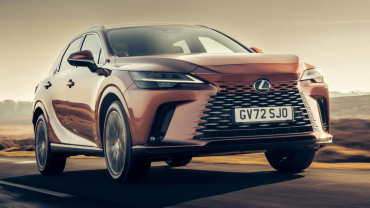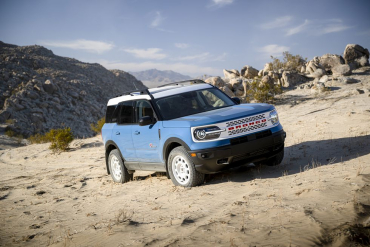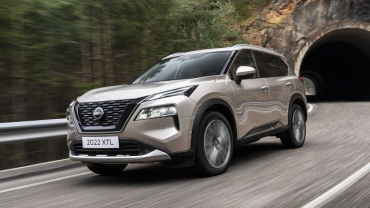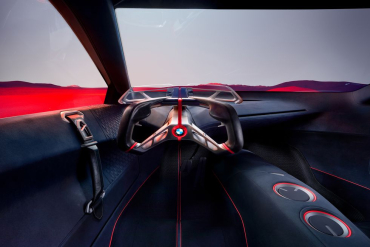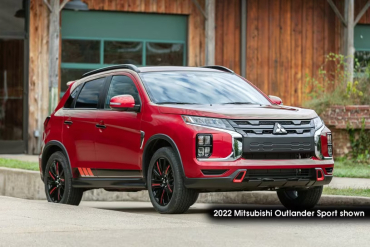
Worldcarblog.com
New Lexus RX 450h+ 2023 review
Lexus's large SUV offers plenty of luxury and tech, but it's not as family-friendly as its size would suggest
Verdict
The new Lexus RX 450h+ delivers on plenty of traditional Lexus attributes. There’s an impressive array of technology on board, the ride is tuned for comfort above all else and the build quality is exemplary. It’s a big SUV so fairly average practicality might be its undoing for some families and keen drivers will be better served elsewhere.
The Lexus RX was one of the first to secure a slice of the burgeoning luxury SUV sector when it launched in the late 1990s and the model line has gone on to reach 3.5million sales globally, helped by its pioneering hybrid technology.

Within the Lexus stable, the RX has been arguably the most successful car at taking on the established players from Germany. The incorporation of a self-charging hybrid powertrain in 2005 was a defining moment for the RX, but since then it’s taken evolutionary steps with a clear focus maintained on comfort and build quality. With this fifth-generation RX, however, Lexus claims it has made “a complete reinvention of the large luxury SUV” and produced a large premium SUV that is more competitive than ever.
The new RX has arrived just at the right time. 2023 has seen both the Mercedes GLE and BMW X5 receive mid-life updates, with hybridisation being added across the range for both models. As an early adopter of hybrid power, it’s no surprise every Lexus RX is electrified.
The entry-level 350h comes with a 247bhp 2.5-litre four-cylinder petrol with self-charging hybrid technology and there’s also a 500h “performance hybrid” with 366bhp from its turbocharged 2.4-litre and plug-in hybrid system - the first time Lexus has mated turbocharging with hybrid power.
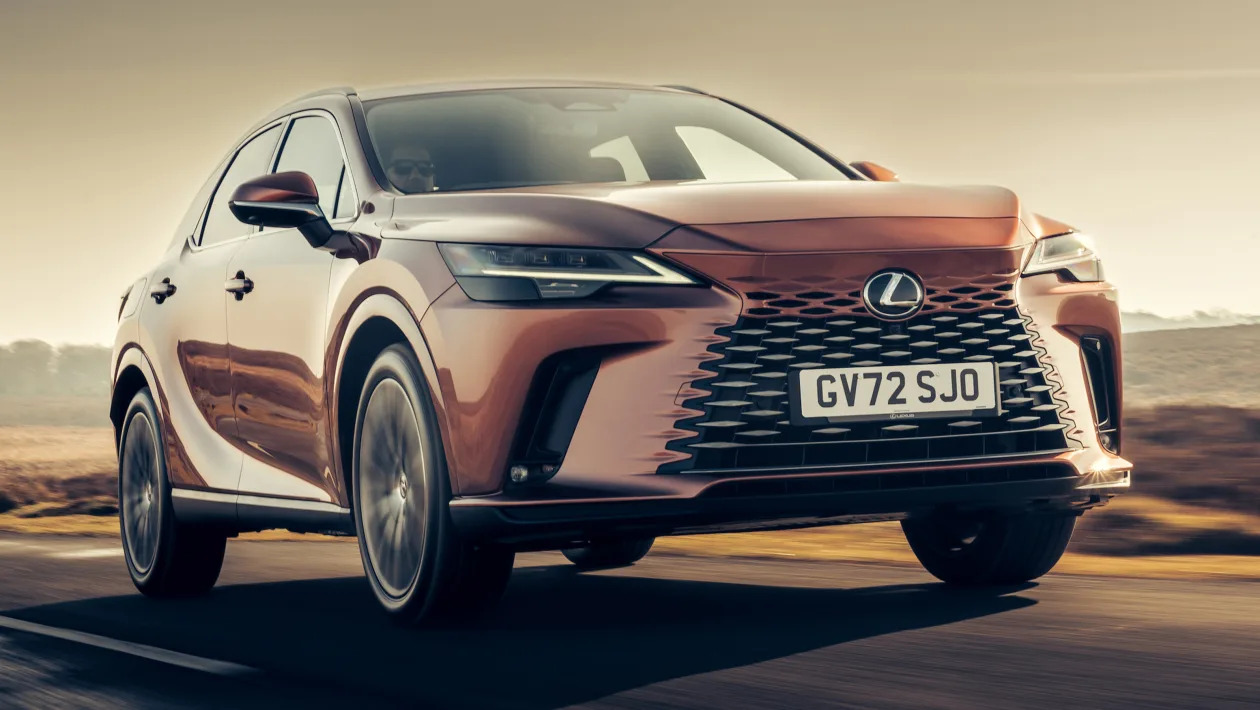
In the middle of the pack sits the 450h+, which borrows its 2.5-litre four-cylinder petrol engine and plug-in hybrid system from the new NX - the first Lexus to offer PHEV capability. The new all-electric RZ (Lexus’s first bespoke full-EV) might look similar to the RX, but that car will use the e-TNGA platform found under the Toyota bZ4X and Subaru Solterra. The RX actually sits on the same GA-K platform as the smaller NX.
Our first taste of the new RX comes in 450h+ form - which Lexus says will account for 55 per cent of sales for its large SUV. The petrol engine combines with a 18.1kWh battery and an electric motor to drive the front wheels but there’s a second electric motor on the rear axle delivering electric four-wheel drive in certain circumstances. On paper the 450h+ sounds potent enough with 304bhp allowing for a 6.5-second 0-62mph time.
It takes a little time to adapt to this powertrain and ensure you’re playing to its strengths. It uses an e-CVT gearbox so if you’re mashing the throttle for an overtake, the petrol engine’s revs will rise to a rather unrefined drone. Hard acceleration overall feels a little underwhelming in the 450h+ although the system is perfectly smooth in its power delivery. Strangely, there are gearshift paddles behind the wheel which display the CVT’s ‘gears’. Given that there’s only one variable gear available in a CVT, moving up and down the simulated steps yourself doesn’t really have much of an effect on the driving experience. You just alter the level of engine braking slightly by raising or lowering the revs, we expect 99 per cent of RX owners won’t ever use the paddles.
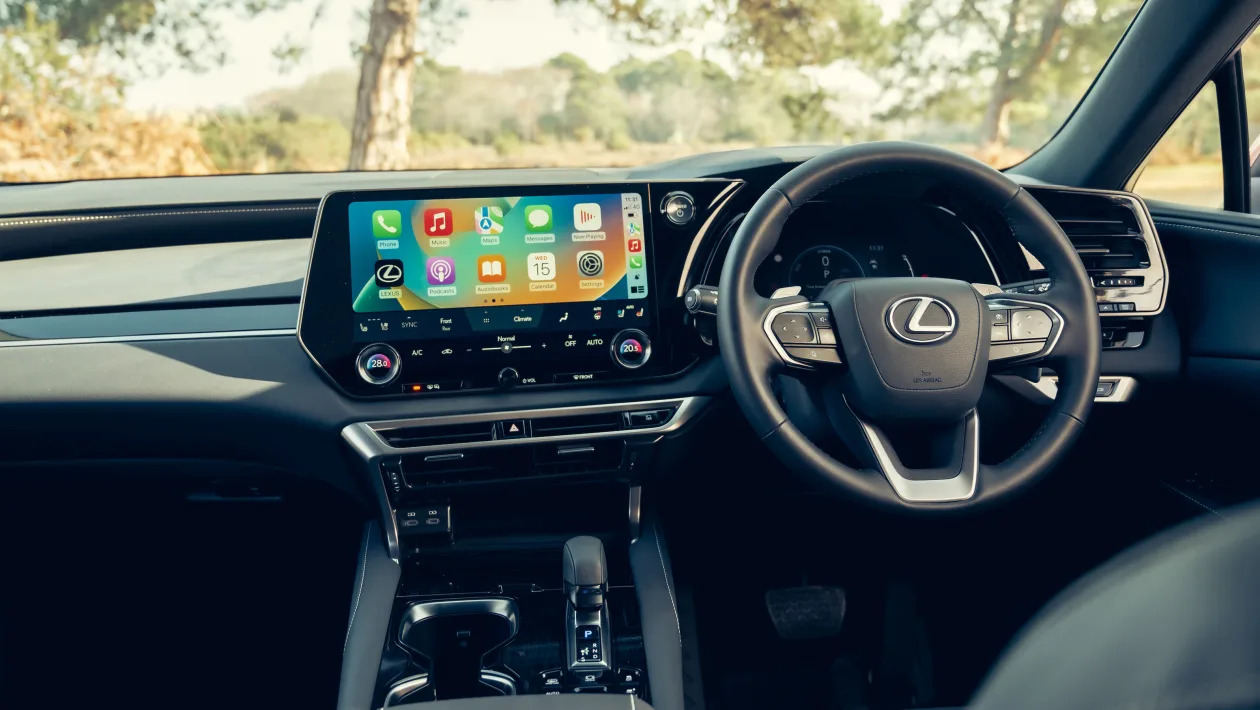
Provided you have enough energy in the battery, you can, of course, switch to electric only mode. The instantaneous torque gives the RX some extra pep around town and silent EV running certainly suits the RX’s calm persona. Lexus claims around 40 miles of electric-only running is possible - most people should get near to this figure with careful driving.
Once that 18.1kWh battery has been emptied (the 6.6kW on-board charger means a full charge takes around two hours and 45 minutes), there’s a second battery that allows the 450h+ to run as a self-charging hybrid. This essentially means you’re always utilising the efficiency benefits of hybrid running. It’s the first time we’ve come across this technology and for PHEV users that might forget to charge or find it impractical to do so regularly, it’s a nice safety net to have. Even with this innovation, the claimed 256.8mpg WLTP fuel economy figure will probably be out of reach for normal driving.
The powertrain rewards relaxed driving and this statement applies to the suspension too. Our car was fitted with adaptive damping, which doesn’t vary too much depending on your chosen setting. Even with 21-inch alloy wheels, it's plainly obvious the RX has been engineered to float over bumps and dips, rather than communicate the road surface to the driver.
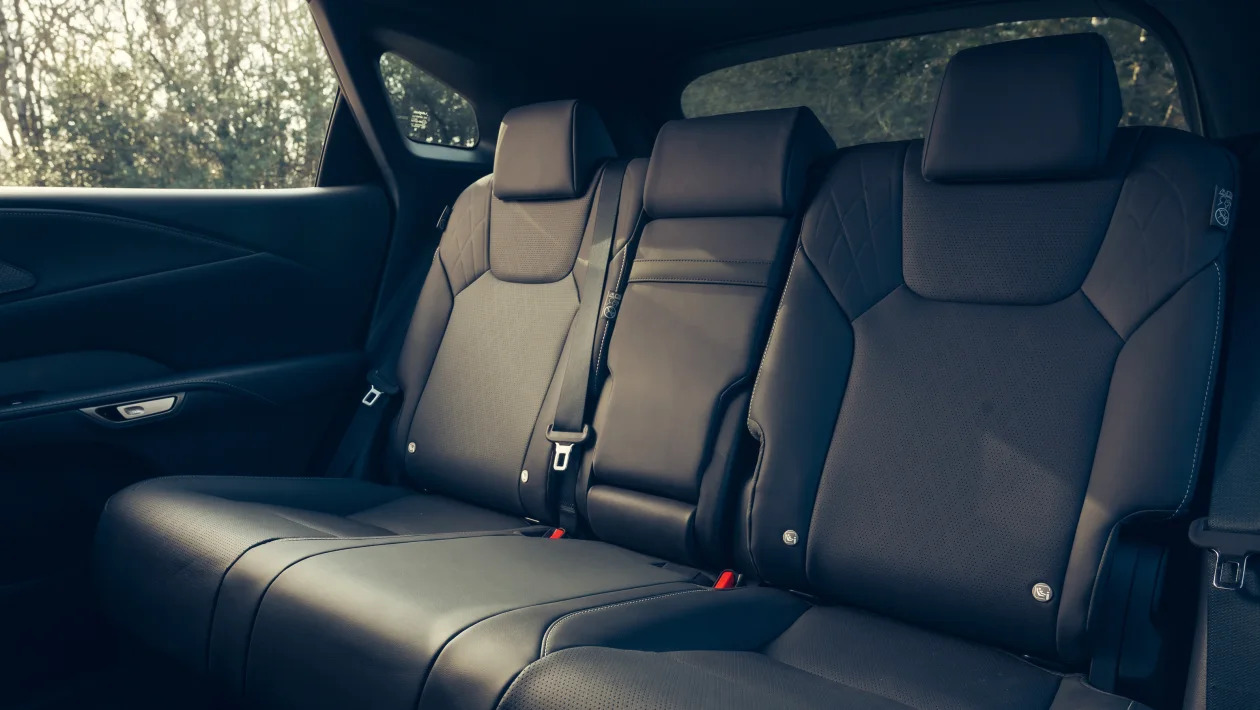
We’re keen to try out the ‘Direct4’ four-wheel drive system exclusively offered on the RX 500h, which apparently keeps pitching under acceleration and braking at bay - that rocking motion was especially prevalent on this 450h+.
Arrive at a series of bends and despite the focus on comfort, the RX can get into a rhythm. The steering wheel has a reassuring weight to it and the handling is tightened by the availability of six degrees of rear-axle steering. You’re always aware of the 2,240kg kerb weight but you can still flow the RX into corners nicely. Get a little too abrupt with steering inputs and you’ll a tendency towards safe, nose-heavy understeer.
Lexus says it has worked hard on improving the RX’s refinement, although the previous model was one of the best in its class in this respect. The powertrain certainly helps, but thicker glass and more sound proofing means this model is supremely quiet even at motorway speeds.
The interior compliments the sedate nature of the RX very well. We tested the top-spec Takumi trim level, which has a huge electric panoramic roof, heated seats front and rear, three-zone climate control and an uprated sound system.
The 14-inch central screen is the main focal point up front and the infotainment system responds immediately to inputs, either from the touchscreen itself or from the steering wheel buttons. It marks a huge step forward from the old track pad setup from the previous Lexus RX and Apple CarPlay or Android Auto can be wirelessly connected as well.
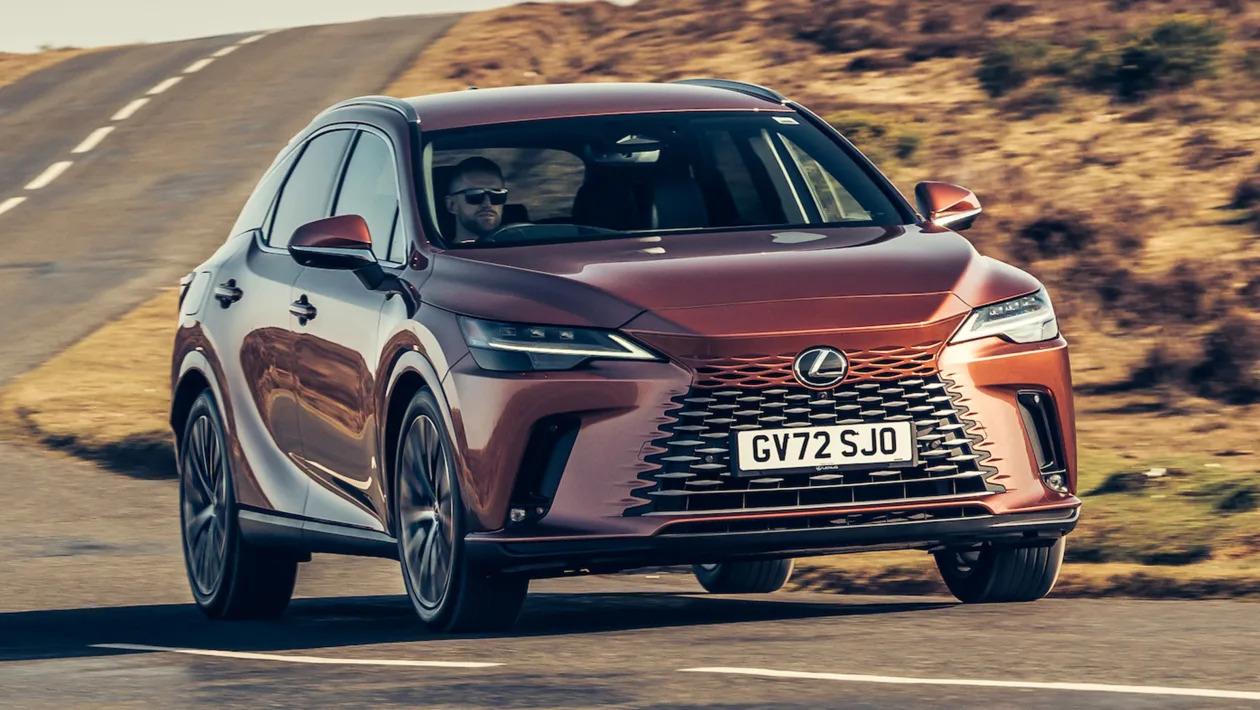
A Mercedes GLE might have the RX beaten in terms of interior wow factor, but the Lexus is up there with the very best for build quality. All the main touchpoints feel solid and things like the door handles and centre console openings are superbly damped. The rear seats can be folded up and down with the touch of a button - parents might prefer the quicker manual lever on lower-spec models.
There are lots of little cubby holes dotted around the cabin and the rear seats will accommodate three adults with no problem, but the lack of a seven-seat model is a bit of a shame. The 461-litre boot is also a little disappointing compared to the competition.
A mid-range ‘Premium Plus Pack’ still offers the panoramic roof as well as a head-up display and wireless charger. It also has the adjustable digital rear view mirror/monitor, which is an impressive bit of kit but slightly superfluous considering rear visibility is perfectly acceptable.
The RX with this 450h+ powertrain kicks off at £64,950 in Premium Plus guise - rising to £79,450 for this Takumi model. Given the new 2023 X5 starts from £66,230 with a mild-hybrid engine and you can’t get a Mercedes GLE for under £77,890, the RX 450h+ appears to be keenly priced.
2023 Ford Bronco Sport Heritage Editions Play the Retro Card
With or without its wayback garb, this baby Bronco remains impressively capable.
Ford continues to channel the rich history of its iconic Bronco 4x4 with the introduction of two new retro-inspired special editions of its compact Bronco Sport SUV.
The 2023 Bronco Sport Heritage Edition and Bronco Sport Heritage Limited Edition celebrate the birth of the Bronco brand with a classic-themed appearance package that takes styling cues from the original 1966 truck. Both variants feature a white roof, white rear badging, white 17-inch aluminum wheels, and a white grille with red BRONCO lettering.
The Bronco Sport Heritage Edition, built on the Big Bend trim level, utilizes Ford's 181-hp turbocharged 1.5-liter inline-three, which is paired with an eight-speed automatic transmission and all-wheel drive. Suspension features include hydraulic front bump stops and specially tuned springs included in Ford’s High-Performance Off-Road Stability Suspension (HOSS) system package, plus five user-selectable "G.O.A.T." terrain modes for off-road driving.
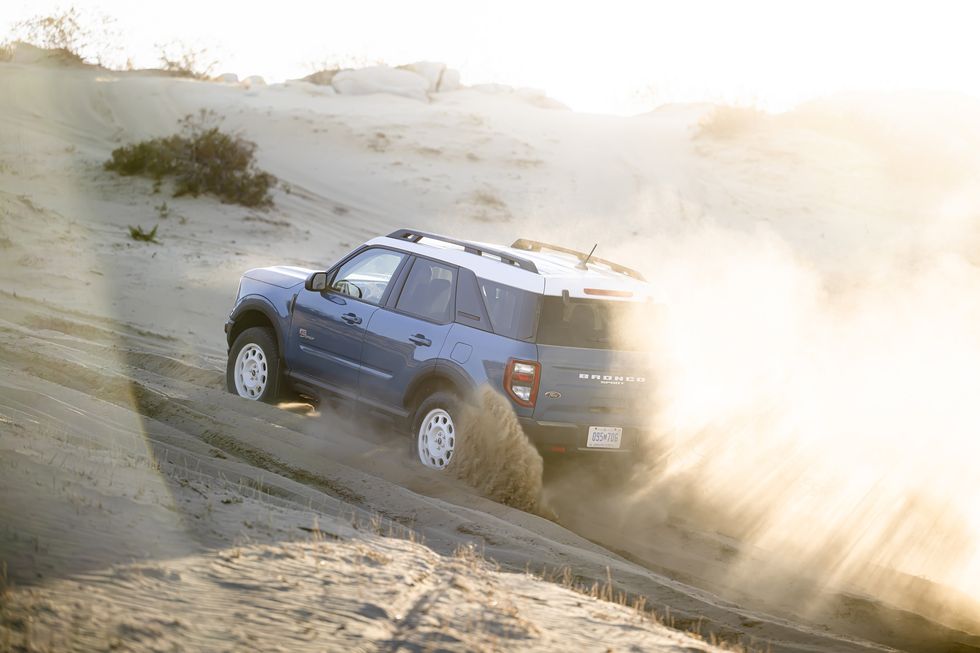
The Heritage Edition's interior styling includes white trim accents, plaid cloth seats, blue-and-red accent stitching, a microsuede center console armrest, and Navy Pier Blue accents on the door panels and dash. Buyers have a choice of seven paint options, including Robin's Egg Blue, a throwback color based on one that was available on the original Bronco.
The pricier Heritage Limited Edition is derived from the Bronco Sport lineup's more off-road-focused Badlands package, which features the larger turbocharged 2.0-liter inline-four, two additional G.O.A.T. modes, a torque-vectoring rear differential, and a lockable center clutch pack for the all-wheel-drive system. Our Peak Blue sample is one of three paint shades available, the others being the lighter Robin's Egg Blue and the intense Yellowstone Metallic.
Heritage Limited Edition–specific features include larger 29-inch all-terrain tires, leather-trimmed seats, and white door inserts. A retro-style plaque adorns the center console, while metal Bronco door badging in the classic '60s script is satisfyingly eye-catching.
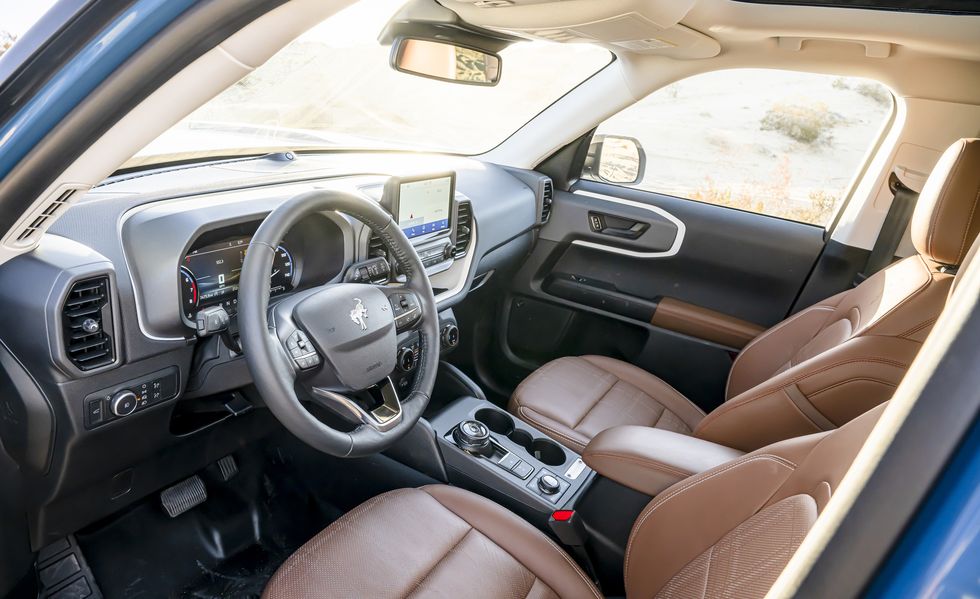
Despite its basis in the humble C2 unibody platform as used in the Escape SUV and Maverick pickup, the Bronco Sport proves to be unexpectedly capable off-road, with the 2.0-liter's 250 horsepower and 277 pound-feet of torque making light work of the steep gullies, embedded boulders, and deep sand that constitute the Johnson Valley area of the Mojave Desert. (So much of the model's off-road development was conducted here that Ford chose to include a geographic coordinate from the area as an Easter egg hidden in the molding of the rear hatch trim.)
An aluminum skid plate, part of the standard Badlands equipment package, eases concerns of stabbing the Bronco Sport's underbody with spiky terrain elements. Despite the Sport's modest ride height, its 8.8-inch ground clearance (on 235/65R-17 tires, the model's largest available) proves to be perfectly adequate for comfortably brisk-paced desert driving as we follow the dusty wake of our guide, Melissa. She is well-versed in the Bronco Sport's abilities, having taken a stock Bronco Sport Badlands to first place in the 1500-mile, off-road Rebelle Rally in both 2021 and 2022.
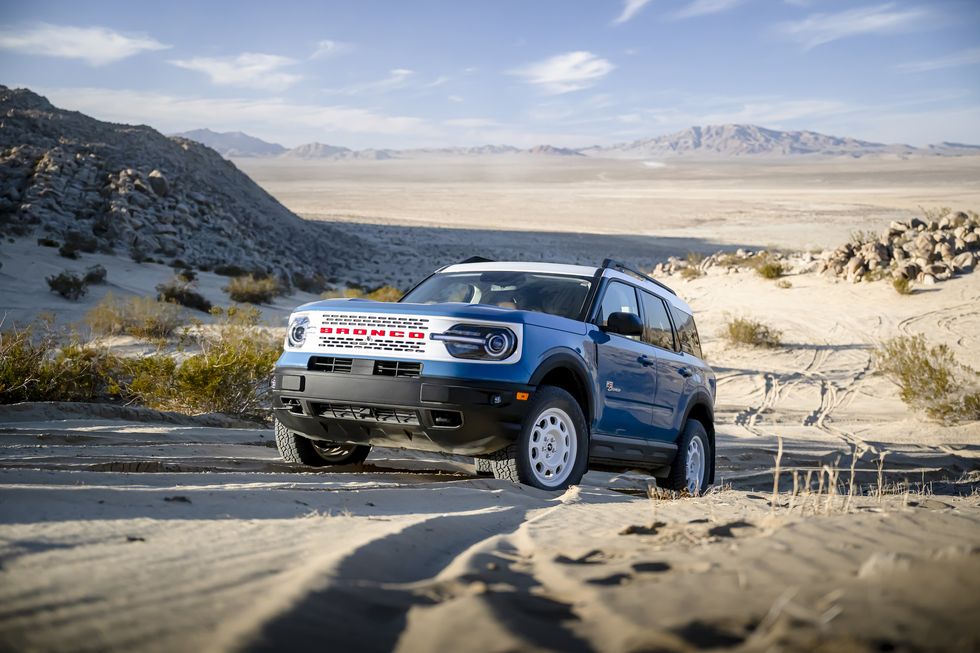
It is the suspension that makes the Bronco Sport, and despite the plethora of off-road driving modes available, this SUV handles even soft trail running just fine in its standard drive mode. Locking in the all-wheel-drive system and the rear differential is more than sufficient for confident thrashing in deeper sand.
All of that would be equally true for the less retro-tastic Badlands model, however. At $46,250, the Heritage Limited Edition is fully kitted out, carrying nearly $5000 worth of features that are optional on the Badlands. Screen that out, and you see that the retro look carries a roughly $2000 premium. One rung down, the $34,245 Heritage Edition represents a roughly $1500 upcharge over the equivalent Big Bend model.
Is that worth it? Well, several miles east of where we drove this Bronco Sport, classic Broncos, stock and modified, are swarming the viewing areas of this year’s King of the Hammers desert road-race competition. For off-road enthusiasts, the appeal of those classic Broncos, the reborn Bronco, and this offshoot Bronco Sport is wrapped up in the combination of capability and aesthetics. The Bronco Sport Heritage Editions lean more heavily on the latter, but to no detriment of the former.
Nissan's most popular models are going electric
Unlike some other manufacturers, Nissan's practice will not be exclusively separate electric models, but will use current names for electrification.
The first in a series of novelties is the Micra, which will be offered in an electric version. However, we now know that other models, the Juke, Qashqai and X-Trail, will also get electric versions. They should appear on the market by 2025.
This was confirmed by the head of Nissan for Europe, Guillaume Cartier, who told the British Autocar that electrification has already begun with the launch of hybrid versions of e-Power, and will end with fully electric models.
Some are exempt: The ban on the production of gasoline and diesel engines from 2035 will not apply to everyone
He says the company "must make use" of electric power on the Qashqai, and the same goes for the smaller Juke and larger X-Trail.
Existing models use the CMF-B mechanical platform, for the Juke launched in 2019, and the CMF-CD, on which the other two SUVs are based.
In the future, all these models are likely to move to the CMF-EV base, which is currently used by the Nissan Ariya and the Renault Megane E-Tech.
At the same time, the Juke should take over the CMF B-EV platform, which will debut with the new Renault 5.
2026 BMW i8 M - First review
Even though the current i8 hasn't lived up to the sporting intentions BMW had for it, that apparently hasn't put the German luxury brand off of high-dollar hybrid sports cars. Development of the next i8—we're a fan of calling it the i8 M, considering it should represent a significant performance improvement over the current model—is underway, and BMW's Vision M Next concept from mid-2019 is proof. A massive increase in power, a longer all-electric driving range, updated styling, and a more capable chassis are all expected to separate the i8 M from the model it will ultimately replace.
What's New for 2026?
The i8 M—or whatever BMW decides to call its next-generation hybrid sports car—will be all-new for the 2026 model year. We expect to find out more as we get closer to the car's on-sale date, which is predicted to be sometime in 2025 as a 2026 model.
Without knowing how the i8 M will be equipped or what options may be available, it's hard to recommend a particular model. We expect the i8 M to be offered in both a fixed-roof coupe body style as well as a ragtop roadster, similar to the previous generation model's lineup.
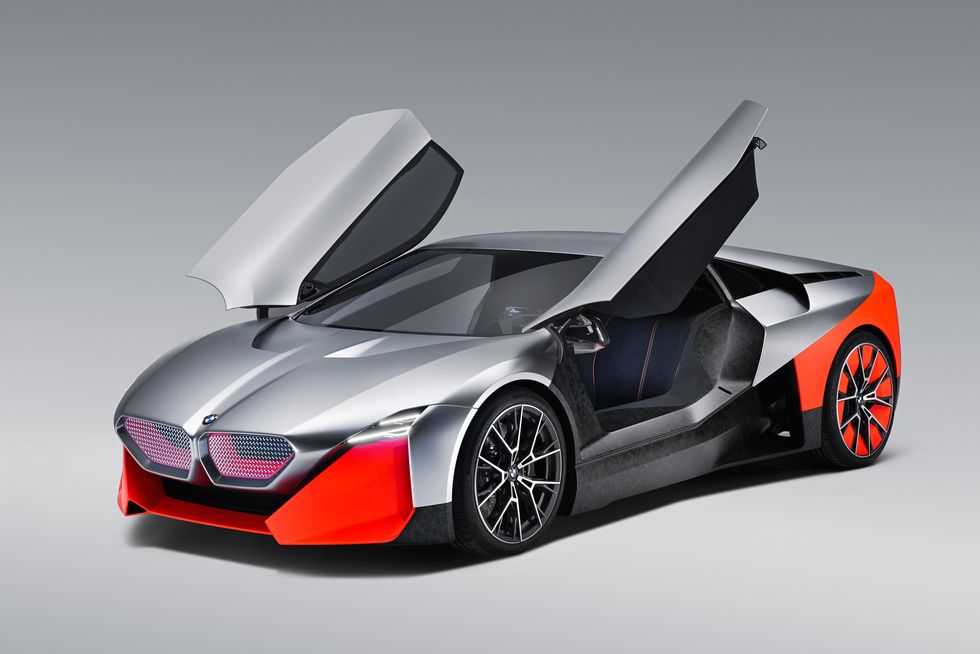
Engine, Transmission, and Performance
The i8 M's plug-in hybrid powertrain is anticipated to follow the same basic setup as the current i8, which means an electric motor driving the front wheels and a mid-mounted gasoline engine and electric motor for the rear wheels. In lieu of the i8's turbocharged 1.5-liter three-cylinder gas engine, BMW has said the new car will offer a turbocharged four-cylinder; the company also claims a total system output—gas and electric power combined—of 591 horsepower, which is far more than the i8's 369-hp output. This up-rated powertrain will help the i8 M compete with rivals such as the Lexus LC500h and the new Chevrolet Corvette E-Ray.
Range, Charging, and Battery Life
The previous generation i8's 18-mile electric driving range was unimpressive to say the least. BMW has been mum on details such as battery size but said the electric driving range for the Vision M Next concept was a claimed 62 miles. That means either BMW's engineers found a way to squeeze a lot more miles out of the current car's 11.6-kWh battery pack or they found space for a much larger unit. It's almost certainly the latter. More information will be available regarding the i8 M's battery, range, and charging capability closer to the car's on-sale date.
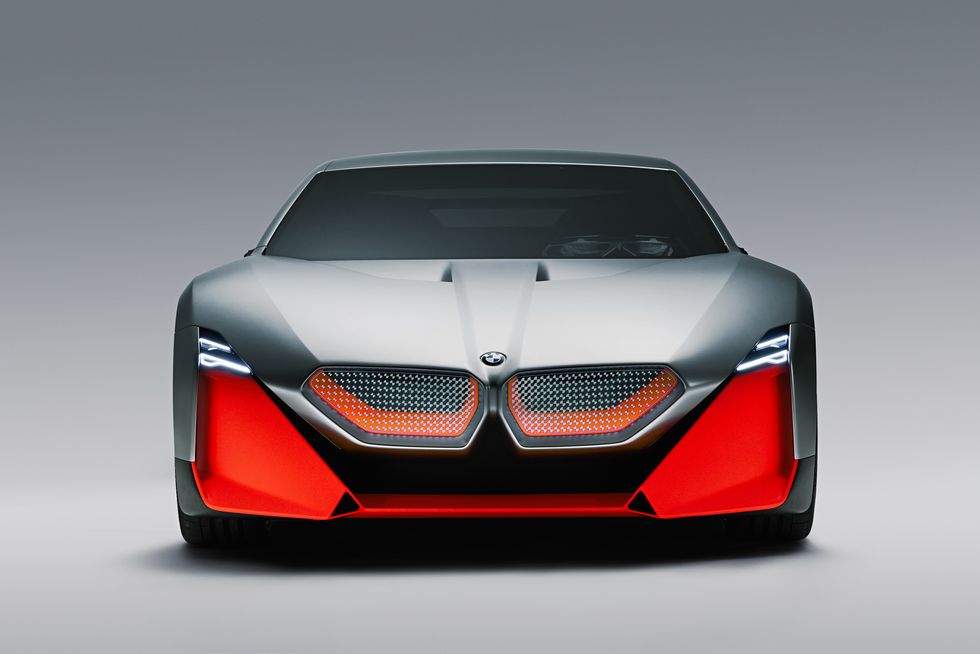
Fuel Economy and Real-World MPG
The EPA has not tested the i8 M or released estimates for its fuel consumption—which is not surprising since the car doesn't exist yet. In addition to improving the electric driving range, we're expecting the i8 M to offer slightly better fuel economy ratings than the current i8, despite an anticipated improvement in acceleration and driving performance. For more information about the i8 M's fuel economy, visit the EPA's website.
Interior, Comfort, and Cargo
Little is known about the i8 M's cabin so far, but we are hoping BMW addresses the i8's difficult ingress and egress by equipping the new car with front-hinged doors and a lower side sill to make the interior more easily accessible. Like the previous car, the i8 M will be BMW's playground for future styling and should feature unique materials, cutting-edge features, and eye-popping designs. Storage and cargo capacity will likely remain limited, but a front trunk (or "frunk") may make an appearance to provide additional luggage space.
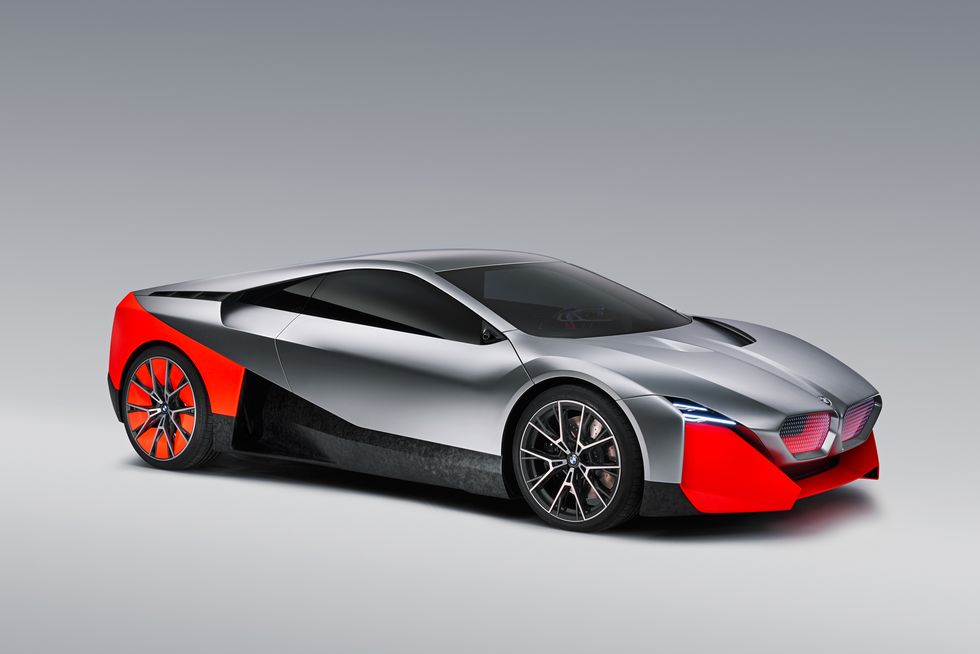
Infotainment and Connectivity
A lot can change in the world of in-car infotainment between now and 2026, so details about what might be offered in the i8 M are anyone's guess. In the Vision M Next concept, BMW showed off a futuristic take on infotainment that the company calls the Boost Pod; it consists of several glass screens and a head-up display to provide the driver access to car-related information and onboard entertainment features.
Safety and Driver-Assistance Features
Considering the i8 M is still a few years off, it's possible more advanced driver-assistance features will be featured, including perhaps a true autonomous driving system. Time will tell. Key safety features are likely to include:
Standard automated emergency braking with pedestrian detection
Standard lane-departure warning with lane-keeping assist
Available adaptive cruise control with semi-autonomous driving mode
Warranty and Maintenance Coverage
BMW's warranty coverage could change between now and 2024, but if everything holds steady in this area, expect the same warranty package that's available on today's lineup. A dedicated hybrid-components warranty is all but a certainty, and we're hoping BMW continues to offer a three-year complimentary maintenance plan for all new models.
Limited warranty covers 4 years or 50,000 miles
Powertrain warranty covers 4 years or 50,000 miles
Hybrid components are covered for 8 years or 100,000 miles
Complimentary maintenance is covered for 3 years or 36,000 miles
2023 Mitsubishi Outlander Sport
The Outlander Sport is not for those who want the latest technology or for those whose passion is driving. Instead, it's for getting passengers and cargo from point A to point B. Its climate and radio controls are easy to use, and having selectable all-wheel drive helps those who live in less temperate climates.
Pros
Well equipped for the price
Excellent warranty coverage
Cons
The ride is rough over bumpy roads
Many interior materials look and feel cheap
Transmission is aggravatingly slow to respond
Raucous drone while accelerating, especially with 2.0-liter engine
What's new
All-wheel drive is now standard across the board
Special Edition trims no longer available
Part of the first Outlander Sport generation introduced in 2011
The 2023 Mitsubishi Outlander Sport is the least expensive SUV in the Japanese automaker's lineup and also one of the oldest vehicle designs currently on sale. The Outlander Sport was introduced in 2011 and has undergone many exterior face-lifts in the intervening years. The styling tweaks help the small crossover look more like a modern offering, but there's only so much you can do to mask the Outlander Sport's aging architecture.
For its 12th year on the market, the Outlander Sport receives standard all-wheel drive across the lineup. Other than that, changes are minimal for 2023. The small SUV continues to offer the same blend of value, practicality and acceptable driving dynamics. We recommend checking out its competitors, the Honda CR-V, Mazda CX-50, Subaru Forester and Hyundai Tucson, before going with the Mitsubishi. But if you just need basic transportation from point A to B with a good warranty, the Outlander Sport might fit the bill. Read our Expert Rating below to get all the details on it.
6.1/10
Edmunds Rating
Our VerdictThe Edmunds Vehicle Testing Team evaluates a fresh batch of vehicles every week, pairing objective assessments at our test track with real-world driving on city streets, freeways and winding roads. The data we gather results in our Expert Ratings. They’re based on 30-plus scores that cover every aspect of the automotive experience.
The Outlander Sport is not for those who want the latest technology or for those whose passion is driving. Instead, it's for getting passengers and cargo from point A to point B. Its climate and radio controls are easy to use, and having selectable all-wheel drive helps those who live in less temperate climates.
Rated for you by America's best test team.
Performance 5.0/10
How does the Outlander Sport drive? The "Sport" in Outlander Sport is a misnomer. The engine is underpowered, the continuously variable automatic transmission performs poorly, and handling and suspension tuning are unrefined. It's a pretty dreary vehicle to drive. Acceleration is jumpy from a stop but settles into a 8.5-second crawl to 60 mph. Under heavy braking, we noted both extreme nosedive and side-to-side wiggle, neither of which instills confidence.
There's very little on-center steering feel, so you must constantly tend to the Outlander Sport's steering, and inputs are met with a delayed reaction from the SUV. Stiff shocks make the Outlander Sport skittish, especially around bumpy corners, yet do nothing to tame the large amounts of body roll.
Comfort 5.0/10
How comfortable is the Outlander Sport? The Outlander Sport lacks the ride comfort and suspension compliance of its competition. For a vehicle that has been on the market for as long as this Mitsu has, there's really no excuse for this. It's OK for around-town use, but long-distance drivers should look elsewhere.
The ride is particularly egregious: harsh over bumps yet floaty over smoother undulations, giving you the worst of both worlds. The leather-upholstered seats in our test vehicle were hard and inflexible, and the cabin was noisy from traffic, road surfaces and the loud climate control fans.
Interior 6.0/10
How’s the interior? If you're the right size, the Outlander Sport's ergonomics are appealing. This SUV is easy to operate, with clearly marked controls and an easy-to-read instrument panel. The large door openings allow easy access to the front seats. Rear passengers will have to duck a bit to maneuver into the seats. Overall, interior space is lacking, with less rear headroom than some competitors and an interior that feels tight from every seat.
Compounding the lack of roominess, the driver's seating position is not particularly adjustable, forcing you into a sit-up-at-the-dinner-table posture. Visibility is also lacking, with large roof pillars and a small rear window that limits your view out of the back.
Technology 6.5/10
How’s the tech? Don't come here if you're looking to get your connectivity or mobile technology fix. What the Outlander Sport provides is basic connectivity. One upshot of the simple infotainment system is that it's very easy to learn to use. Apple CarPlay and Android Auto aren't standard on the base model, but the standard Bluetooth connectivity is simple to set up.
Basic active safety features such as automatic emergency braking are not standard and only appear on the midrange SE trim or higher. There's no adaptive cruise control at any trim level.
Storage 6.5/10
How’s the storage? The Outlander Sport doesn't excel in any area but works acceptably for cargo duty. The 60/40-split rear bench seat can be folded without removing the headrests or sliding the seats forward, but the release button is difficult to access from the cargo area. Once folded, the load floor is flat and expansive, and the tall roofline makes loading easy.
There's an average amount of small-item storage inside the Outlander Sport. The door pockets are large and can accommodate a medium-size water bottle, and the cubby under the center stack can hold a phone. There are two cupholders and a cubby situated in the center console. Car seats can be accommodated in the two outboard rear seating positions thanks to easily accessible lower hooks, while the upper hooks can only be accessed from the cargo area.
Fuel Economy 6.0/10
How’s the fuel economy? The Outlander Sport GT is rated to get 25 mpg in combined driving (23 city/28 highway). We saw an average of 22.7 mpg over the course of three fill-ups while driving on city, highway and mountain roads. While on the low side, this type of result is expected for an underpowered vehicle.
Value 8.0/10
Is the Outlander Sport a good value? For those who value cost above all else, the Outlander Sport offers the basics as a compact SUV. We could easily recommend any number of other models, but they would all cost more. Our test vehicle came in a few thousand dollars under direct competitors. But you may be willing to spend more to get better performance, additional connectivity features and driver assists that are simply not available on the Outlander Sport.
The Outlander Sport's design is dated, but it feels sturdily assembled even if the quality of materials is subpar. On the plus side, Mitsubishi offers a very strong warranty and a roadside assistance program similar to those found on premium vehicles. That peace of mind certainly adds to the Outlander Sport's value proposition.
Wildcard 6.010
A jack-of-all-trades but a master of none, the Outlander Sport is purely a machine for transportation. Any sort of fun or enjoyment will come from the overactive imagination of the driver. As an easily approachable, no-nonsense car, the Outlander Sport appeals to those who prioritize a low price above any kind of driving satisfaction. It's not the most charismatic car you'll meet on the road, but thanks to its warranty and roadside assistance, it is dependable.
Which Outlander Sport does Edmunds recommend?
It might be tempting to get the cheapest Outlander Sport available, but we think the midtier LE trim hits the sweet spot and is worth spending a few thousand more for. That model gets you a tech upgrade with a larger 8-inch touchscreen and Apple CarPlay and Android Auto smartphone integration. You'll also enjoy extra creature comforts like a leather-wrapped steering wheel and heated front seats.
Mitsubishi Outlander Sport models
The 2023 Mitsubishi Outlander Sport is available in five trim levels: S, ES, LE, SE and GT. All but the GT are powered by a 2.0-liter four-cylinder engine (148 horsepower, 145 lb-ft of torque). The GT receives a more powerful 2.4-liter four-cylinder engine (168 hp, 167 lb-ft). Both engines come paired with a continuously variable transmission (CVT) and all-wheel drive is standard on all models.
S
The base S model comes impressively equipped. Highlights include:
16-inch wheels
LED headlights
Automatic high beams
Heated, power exterior mirrors
Automatic wipers
Height-adjustable driver's seat
60/40-split folding rear seats
Automatic climate control
7-inch touchscreen
Drive mode selector
Four-speaker audio system
Single USB port
Auto-dimming rearview mirror
These driver aids are standard on all trim levels:
Forward collision mitigation (warns you of an impending collision and applies the brakes in certain scenarios)
Lane departure warning (alerts you if the vehicle begins to drift out of its lane)
Automatic high-beam assist
ES
The ES adds:
18-inch alloy wheels
LED foglights
LE
Stepping up to the LE trim adds:
Leather-wrapped steering wheel
8-inch touchscreen
Apple CarPlay and Android Auto smartphone integration
Heated front seats with contrast stitching
Additional front and rear USB ports
Voice recognition controls
SE
Moving up to the SE trim adds:
Power-folding mirrors
Hands-free keyless entry and push-button ignition
Six-speaker audio system
Blind-spot warning with rear cross-traffic warning (alerts you if a vehicle is in your blind spot during a lane change or while reversing)
GT
Besides the more powerful engine, the range-topping GT model gets you:
Black roof rails
Leather upholstery
Black headliner
Power-adjustable driver's seat
2023 Jeep Grand Cherokee 4xe PHEV Costs a Lot to Save a Little
Faithful at-home charging can keep the plug-in-hybrid Grand Cherokee away from the gas pumps, but bringing one home won't be cheap.
Hearing the Jeep Grand Cherokee 4xe described as the "most fuel-efficient Jeep ever" gives us the warm fuzzies. It feels like a win for the world and makes us want to parade through an aisle at Whole Foods, high-fiving every farm-to-fork enthusiast until our palms turn red. But while the 4xe's EPA-estimated 56 MPGe and 26 miles of electric-only range are good for a Grand Cherokee, the plug-in-hybrid option is an expensive one.
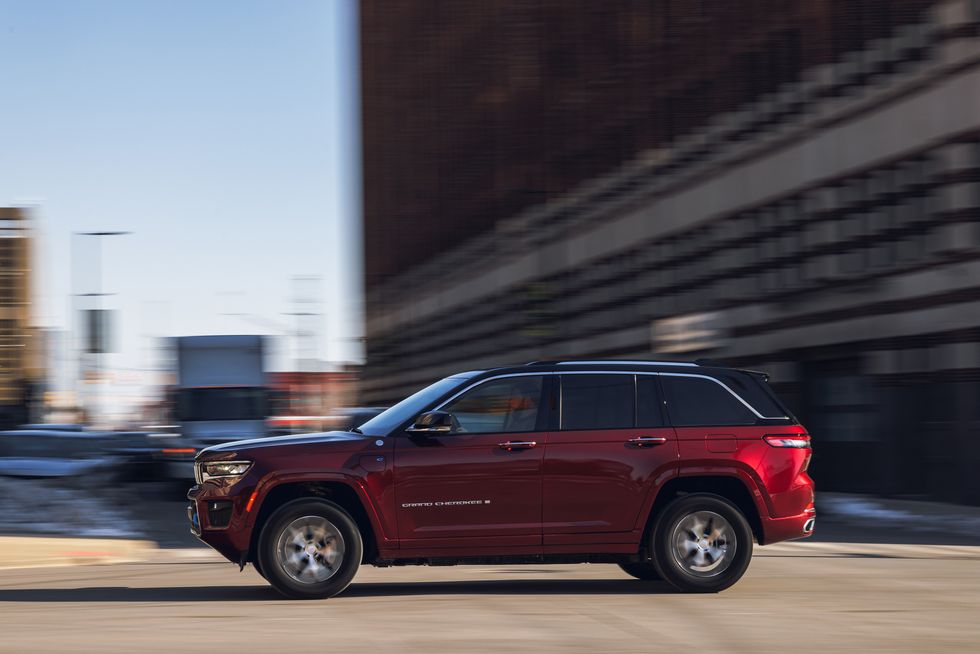
That's not to downplay the effort by Jeep to reduce its wonderfully luxurious SUV's usage of gasoline. The Grand Cherokee, which was redesigned last year, is an absolute honey on the road. With a firm brake pedal, linear steering, and a smooth ride, the Grand Cherokee moves with confidence. Its lavish interior and robust four-wheel-drive system make it akin to a Kia Telluride that's graduated from off-road boot camp. Unlike its Wrangler 4xe plug-in-hybrid sibling, the Grand Cherokee 4xe is subdued and quiet at speed. At idle, however, a grumpy 46 decibels from the inline-four echo throughout the cabin.
A 270-hp turbo 2.0-liter and two electric motors bring the total output to 375 horsepower and 470 pound-feet of torque, a combination potent enough to make passengers ask, "This is a four-cylinder?" (which, really, is the best compliment a four-cylinder can hope for). We noticed some hesitation when accelerating hard from low speed as the gas engine and electric motor bickered over whose turn it was.
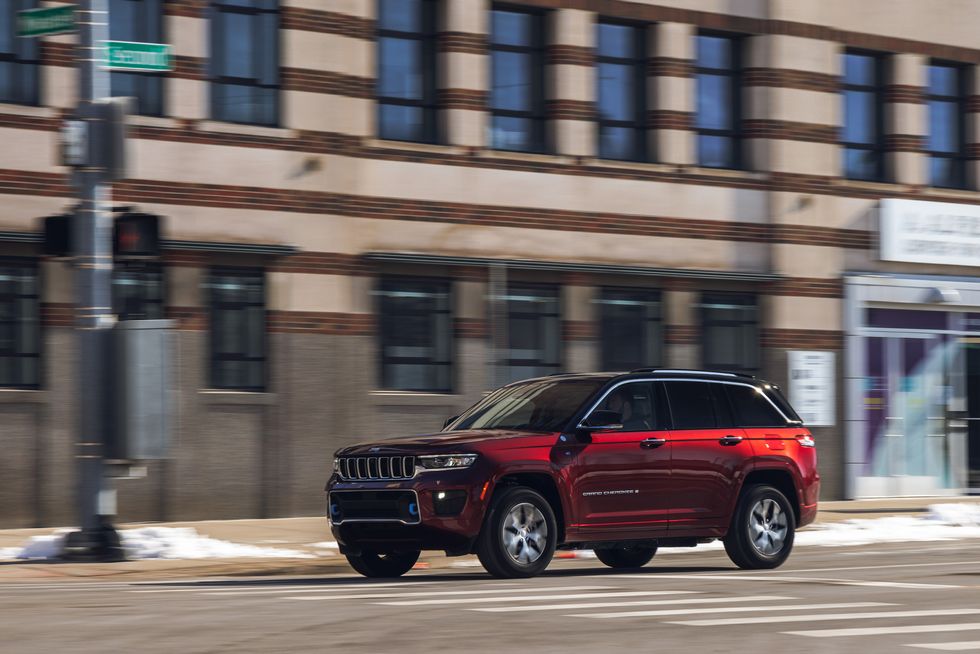
In the Wrangler, we noted this powertrain's rocky transitions between gas and electric propulsion, although they were somewhat lost amid the Wrangler's general cacophony. In the vastly more polished Grand Cherokee, the powertrain's hesitation and its abrupt transitions stand out.
Eventually, the powertrain suffered a more serious fault, and the hybrid system went silent. As a result, we were unable to record an as-tested fuel economy, nor can we provide you with the 4xe's 75-mph highway fuel-economy results.
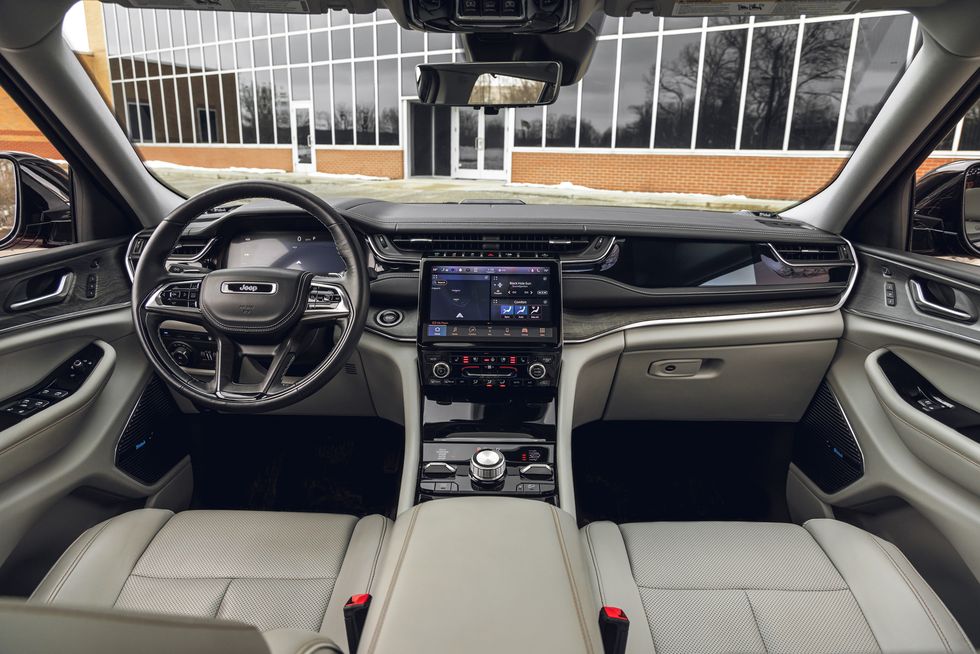
We were able to perform instrumented testing before the hybrid-system failure and found that the 4xe is the quickest version of the new Grand Cherokee. It springs to 60 mph in 5.3 seconds and hits 100 mph in 13.9 seconds, right as it reaches a quarter-mile. That's 0.3 second quicker to 60 mph and 1.3 seconds sooner to 100 than the discontinued V-8 version. When it comes to lugging, the 4xe's 6000-pound maximum towing capacity is 200 pounds short of the V-6 and 1200 less than the dead V-8 model.
The Grand Cherokee 4xe starts at $61,660, which is $16,830 more than the base four-wheel-drive V-6 Laredo. The 4xe, though, skips the Laredo trim and is available only in Limited, Trailhawk, Overland, Summit, and Summit Reserve grades. Comparing like trims, the 4xe's upcharge over the V-6 variants with four-wheel drive ranges from $8685 to $10,010—although that can be at least partially offset by the PHEV's $7500 federal tax credit.
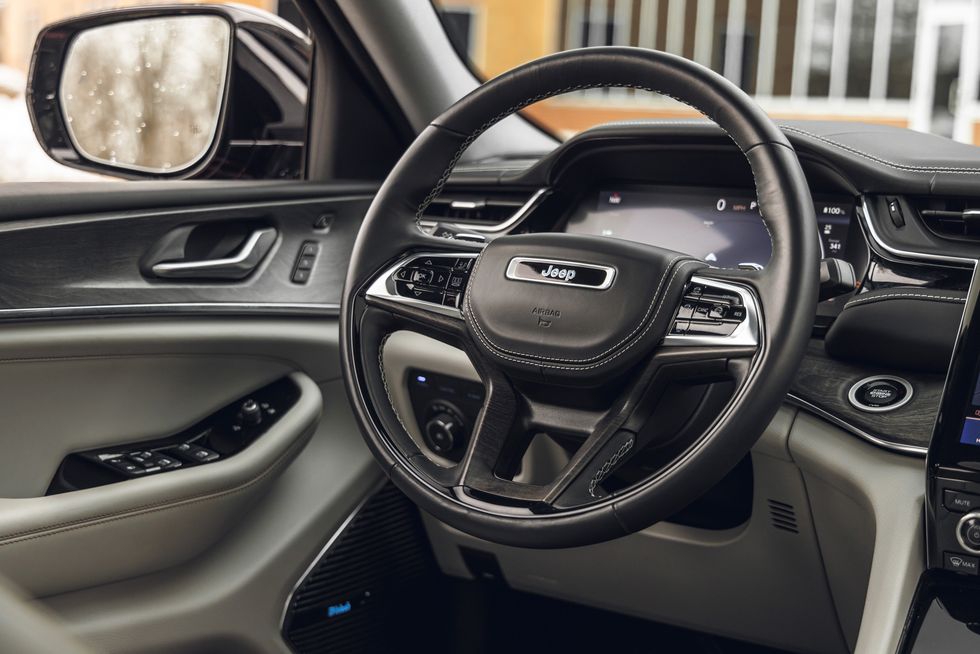
Our Overland test rig rumbled in with a $77,525 price tag. The two largest contributions to its bill were optional packages. A Luxury Tech Group IV ($2155) included nappa leather seats with a massaging front row, wireless device charging, and window shades for the back seats. An Advanced Protech Group III ($2235) added head-up display, night vision, and additional driver-assistance features.
This higher-trim model also had the available 10.3-inch front passenger interactive display screen. Taking the opportunity to nerd out, we connected Valve's Steam Deck handheld gaming PC via an HDMI cable while waiting for a takeout order. Although playing the video game SnowRunner in a snowy parking lot sounds ironic and fun, we found the screen to be incredibly dim, even at night with the brightness fully cranked.
Owners with short commutes may be able to avoid gas stations for months, bouncing between the workplace and home, where a typical 240-volt charging connection to the 4xe's 7.2-kW onboard charger can juice up the roughly 14.0-kWh battery in about 2.5 hours. For folks plugging into a standard wall socket, the charge could take eight to 15 hours, depending on the home’s outlet. However, footing the bill for the pricey Grand Cherokee 4xe just to avoid gas stations seems like an overpriced convenience.
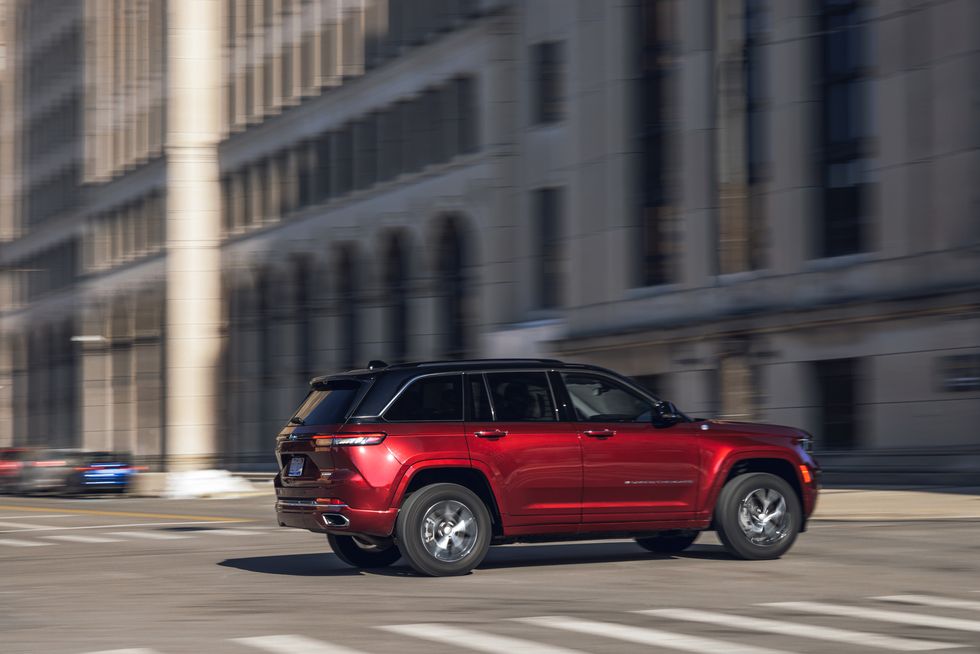
Specifications
2023 Jeep Grand Cherokee 4xe
Vehicle Type: front-engine, front-motor, 4-wheel-drive, 5-passenger, 4-door wagon
PRICE
Base/As Tested: $61,660/$77,525
Options: Overland trim (air springs, front tow hooks, hands-free liftgate, LED headlights, backlit door handles, heated and power folding exterior mirrors, 20-inch wheels, automatic wipers, ambient interior lighting, auto dimming rearview mirror power tilt/telescoping steering column, power-folding second row rear seats, McIntosh stereo, front-parking assist), $8015; Advanced Protech Group III (head-up display, night vision, surround-view camera, off-road camera), $2235; Luxury Tech Group IV (nappa leather seats, digital rearview mirror display, wireless device charging, massaging front seats, four-zone climate control), $2155; front passenger interactive display, $1095; Off-Road Group, (Goodyear All-Terrain tires, electronically controlled limited slip rear differential, underbody skid plates), $1095; black-painted roof, $775; Velvet Red Pearlcoat paint, $495
POWERTRAIN
turbocharged and intercooled DOHC 16-valve 2.0-liter inline-4, 270 hp, 295 lb-ft + 2 AC motors, 44 and 134 hp, 39 and 195 lb-ft (combined output: 375 hp, 470 lb-ft; 14.0-kWh lithium-ion battery pack (C/D est); 7.2-kW onboard charger)
Transmission: 8-speed automatic
CHASSIS
Suspension, F/R: multilink/multilink
Brakes, F/R: 13.9-in vented disc/13.8-in vented disc
Tires: Goodyear Wrangler All Terrain Adventure
265/60R-18 110T M+S
DIMENSIONS
Wheelbase: 116.7 in
Length: 193.5 in
Width: 77.5 in
Height: 70.9 in
Passenger Volume, F/R: 56/51 ft3
Cargo Volume, F/R: 71/38 ft3
Curb Weight: 5664 lb
C/D TEST RESULTS
60 mph: 5.3 sec
1/4-Mile: 13.9 sec @ 100 mph
Results above omit 1-ft rollout of 0.3 sec.
Rolling Start, 5–60 mph: 6.1 sec
Top Gear, 30–50 mph: 3.4 sec
Top Gear, 50–70 mph: 4.3 sec
Top Speed (gov ltd): 117 mph
Braking, 70–0 mph: 189 ft
Roadholding, 300-ft Skidpad: 0.79 g
EPA FUEL ECONOMY
Combined/City/Highway: 23/23/24 mpg
Combined Gasoline + Electricity: 56 MPGe
EV Range: 26 mi
Source: caranddriver.com
The electric Golf is coming
After 14 years at the top of Europe's best-selling car list, the Volkswagen Golf lost its throne to the Peugeot 208 in 2022.
In fact, the compact car from Wolfsburg didn't even make it onto the podium as the affordable Dacia Sandero came second, while Volkswagen's T-Roc crossover took third place. The small Fiat/Abarth 500 came in fourth place "closely" ahead of the Golf, while Toyota's subcompact hatchback Yaris is not far behind, writes Klix.ba
In order to improve sales, Volkswagen is working on a refreshed version of the eighth generation Golf, which will go on sale in 2024. Meanwhile, rumors are circulating that the German giant is thinking about the future and is preparing a popular name for the inevitable electric future. Autocar writes that ID. The Life concept presented at the Munich fair in 2021 is "dead", but that the new concept will be presented in March.
This concept will herald a new electric car that will be a production model for 2025, and will also become the first Volkswagen Group car to use the MEB-Plus platform developed for front-wheel drive. The platform is believed to support the two electric motors required for the four-wheel drive models. The British magazine calls the concept the ID.2 model, but insiders claim that the production car will actually carry the Golf name.
In terms of dimensions, the car will be longer than the Polo, but shorter than the conventional Golf with a length of around 4,250 mm. A dedicated platform for the electric car will result in a short overhang to maximize the wheelbase and allow for the interior space offered by the Golf. The car is expected to weigh between 1,600 and 1,700 kg and will also get a GTI version.
Autocar's source from the company revealed that the decision has been made to abandon the GTX suffix, which is currently used for the sportier versions of the ID.4 and ID.5 models. Also, the powerful hatchback ID.3 and the high-performance van ID are expected to follow. Buzz.
In May at the earliest, we could see a new electric concept that announces the electric GTI, and if that doesn't happen, then the premiere is possible in September.
Although the Golf based on the MQB platform and with conventional engines is produced in Wolfsburg, the electric model will be produced by SEAT at the Martorell plant in Spain. It is also where the Cupra Urban Rebel will be produced. Skoda will also get its version of a small electric car.
If the information is correct, it means that the eighth generation Golf will peacefully coexist with its electric "cousin" for several years. Given the arrival of a redesigned model based on the MQB platform in 2024, that means VW intends to sell it until at least 2027 or 2028. In the end, the company will be forced to consign the gasoline and diesel versions to history, as the European Union has voted to ban the sale of new vehicles with SUS engines from 2035 onwards.

